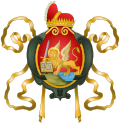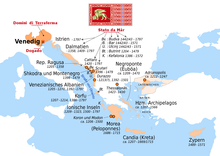Republic of Venice
The Republic of Venice (Italian: Repubblica di Venezia;[1] Venetian: Repùblica de Venèsia) or Venetian Republic (Italian: Repubblica Veneta;[2] Venetian: Repùblica Vèneta), traditionally known as La Serenissima (English: Most Serene Republic of Venice; Italian: Serenissima Repubblica di Venezia; Venetian: Serenìsima Repùblica Vèneta), was a sovereign state and maritime republic in what is now northeastern Italy. It lasted from 697 AD until 1797 AD. Centered on the lagoon communities of the prosperous city of Venice, the republic grew into a trading power during the Middle Ages and strengthened this position in the Renaissance. Citizens spoke the still-surviving Venetian language, although publishing in (Florentine) Italian became the norm during the Renaissance.
Most Serene Republic of Venice | |||||||||||||
|---|---|---|---|---|---|---|---|---|---|---|---|---|---|
| 697–1797 | |||||||||||||
.svg.png) Banner of Saint Mark
 Coat of arms
| |||||||||||||
 Territorial evolution of the Republic and her colonies and holdings. | |||||||||||||
| Capital | Eraclea (697–742) Malamocco (742–810) Venice (810–1797) | ||||||||||||
| Common languages | |||||||||||||
| Government | Parliamentary oligarchic merchant republic with elective monarchistic features | ||||||||||||
| Doge | |||||||||||||
• 697–717 (first) | Paolo Lucio Anafestoa | ||||||||||||
• 1789–1797 (last) | Ludovico Manin | ||||||||||||
| Legislature | Great Council | ||||||||||||
• Upper Chamber | Senate | ||||||||||||
• Lower Chamber | Council of Ten | ||||||||||||
| Historical era | Middle Ages – Early modern period | ||||||||||||
• Established1 | 697 | ||||||||||||
• Golden Bull of Alexios I | 1082 | ||||||||||||
| 1177 | |||||||||||||
| 1204 | |||||||||||||
• Battle of Motta | 1412 | ||||||||||||
| 1571 | |||||||||||||
| 1718 | |||||||||||||
| 1797 | |||||||||||||
| Currency | Venetian ducat Venetian lira | ||||||||||||
| |||||||||||||
| Today part of | Italy Slovenia Croatia Montenegro Albania Greece Cyprus Turkey Ukraine/Russia | ||||||||||||
a. ^ Paolo Lucio Anafesto is traditionally the first Doge of Venice, but John Julius Norwich suggests that this may be a mistake for Paul, Exarch of Ravenna, and that the traditional second doge Marcello Tegalliano may have been the similarly named magister militum to Paul. Their existence as doges is uncorroborated by any source before the 11th century, but as Norwich suggests, is probably not entirely legendary. Traditionally, the establishment of the Republic is, thus, dated to 697 AD. | |||||||||||||
In its early years, it prospered on the salt trade. In subsequent centuries, the city state established a thalassocracy. It dominated trade on the Mediterranean Sea, including commerce between Europe and North Africa, as well as Asia. The Venetian navy was used in the Crusades, most notably in the Fourth Crusade. However, Venice perceived Rome as an enemy and maintained high levels of religious and ideological independence personified by the Patriarch of Venice and a highly developed independent publishing industry that served as a haven from Roman Catholic censorship for many centuries. Venice achieved territorial conquests along the Adriatic Sea. Venice became home to an extremely wealthy merchant class, who patronized renowned art and architecture along the city's lagoons. Venetian merchants were influential financiers in Europe. The city was also the birthplace of great European explorers, such as Marco Polo, as well as Baroque composers such as Vivaldi and Benedetto Marcello.
The republic was ruled by the Doge, who was elected by members of the Great Council of Venice, the city-state's parliament, and ruled for life. The ruling class was an oligarchy of merchants and aristocrats. Venice and other Italian maritime republics played a key role in fostering capitalism. Venetian citizens generally supported the system of governance. The city-state enforced strict laws and employed ruthless tactics in its prisons.
The opening of new trade routes to the Americas and the East Indies via the Atlantic Ocean marked the beginning of Venice's decline as a powerful maritime republic. The city state suffered defeats from the navy of the Ottoman Empire. In 1797, the republic was plundered by retreating Austrian and then French forces, following an invasion by Napoleon Bonaparte, and the Republic of Venice was split into the Austrian Venetian Province, the Cisalpine Republic, a French client state, and the Ionian French departments of Greece. Venice became part of a unified Italy in the 19th century.
Name
It was formally known as the Most Serene Republic of Venice (Italian: Serenissima Repubblica di Venezia, Venetian: Serenìsima Repùblica Vèneta, or Venetian: Repùblica de Venesia) and is often referred to as La Serenissima, in reference to its title as one of the "Most Serene Republics".
History
During the 5th century, northeast Italy was devastated by the Germanic barbarian invasions. A large number of the inhabitants moved to the coastal lagoons, looking for a safer place to live. Here they established a collection of lagoon communities, stretching over about 130 km (81 mi) from Chioggia in the south to Grado in the north, who banded together for mutual defence from the Lombards, Huns, and other invading peoples as the power of the Western Roman Empire dwindled in northern Italy.
These communities were subjected to the authority of the Byzantine Empire.
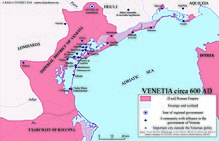
At some point in the first decades of the eighth century, the people of the Byzantine province of Venice elected their first leader Ursus (or Orso Ipato), who was confirmed by Constantinople and given the titles of hypatus and dux. He was the first historical Doge of Venice. Tradition, however, first attested in the early 11th century, states that the Venetians first proclaimed one Anafestus Paulicius duke in 697, though this story dates to no earlier than the chronicle of John the Deacon. Whichever the case, the first doges had their power base in Heraclea.
Rise
Ursus's successor, Deusdedit, moved his seat from Heraclea to Malamocco in the 740s. He was the son of Ursus and represented the attempt of his father to establish a dynasty. Such attempts were more than commonplace among the doges of the first few centuries of Venetian history, but all were ultimately unsuccessful. During the reign of Deusdedit, Venice became the only remaining Byzantine possession in the north and the changing politics of the Frankish Empire began to change the factional divisions within Venetia.
One faction was decidedly pro-Byzantine. They desired to remain well-connected to the Empire. Another faction, republican in nature, believed in continuing along a course towards practical independence. The other main faction was pro-Frankish. Supported mostly by clergy (in line with papal sympathies of the time), they looked towards the new Carolingian king of the Franks, Pepin the Short, as the best provider of defence against the Lombards. A minor, pro-Lombard faction was opposed to close ties with any of these further-off powers and interested in maintaining peace with the neighbouring (and surrounding, but for the sea) Lombard kingdom.
Early Middle Ages

The successors of Obelerio inherited a united Venice. By the Pax Nicephori (803–814), the two emperors had recognised that Venice belonged to the Byzantine sphere of influence. Many centuries later, the Venetians claimed that the treaty had recognised Venetian de facto independence, but the truth of this claim is doubted by modern scholars. A Byzantine fleet sailed to Venice in 807 and deposed the Doge, replacing him with a Byzantine governor. Nevertheless, during the reign of the Participazio family, Venice grew into its modern form.
Though Heraclean by birth, Agnello, the first Participazio doge, was an early immigrant to Rialto and his dogeship was marked by the expansion of Venice towards the sea via the construction of bridges, canals, bulwarks, fortifications, and stone buildings. The modern Venice, at one with the sea, was being born. Agnello was succeeded by his son Giustiniano, who stole the remains of Saint Mark the Evangelist from Alexandria, took them to Venice, and made him the republic's patron saint. According to tradition, Saint Mark was the founder of the Patriarchate of Aquileia.
With the patriarch's flight to Grado after the Lombard invasion, the patriarchate split into two: one on the mainland, under the control of the Lombards and later the Franks, and the other in Grado on the lagoons and the areas under Byzantine control. This would later become the Patriarchate of Venice. With the apostle's reliquiae in its hands, Venice could again claim to be the rightful heir of Aquileia. In the Late Middle Ages, this would be the basis for legitimizing the seizure of the patriarchy's vast territories in Friuli and eastwards.

During the reign of the successor of the Participazio, Pietro Tradonico, Venice began to establish its military might, which would influence many a later crusade and dominate the Adriatic for centuries. Tradonico secured the sea by fighting Narentine and Saracen pirates. Tradonico's reign was long and successful (837–64), but he was succeeded by the Participazio and a dynasty appeared to have been finally established. Around 841, the Republic of Venice sent a fleet of 60 galleys (each carrying 200 men) to assist the Byzantines in driving the Arabs from Crotone, but it failed.[3] In 1000, Pietro II Orseolo sent a fleet of 6 ships to defeat the Narentine pirates from Dalmatia.[4]
High Middle Ages

In the High Middle Ages, Venice became extremely wealthy through its control of trade between Europe and the Levant, and it began to expand into the Adriatic Sea and beyond. In 1084, Domenico Selvo personally led a fleet against the Normans, but he was defeated and lost nine great galleys, the largest and most heavily armed ships in the Venetian war fleet.[5] Venice was involved in the Crusades almost from the very beginning. Two hundred Venetian ships assisted in capturing the coastal cities of Syria after the First Crusade. In 1110, Ordelafo Faliero personally commanded a Venetian fleet of 100 ships to assist Baldwin I of Jerusalem and Sigurd I Magnusson, king of Norway in capturing the city of Sidon (in present-day Lebanon).[6] In 1123, they were granted virtual autonomy in the Kingdom of Jerusalem through the Pactum Warmundi.[7]
The Venetians also gained extensive trading privileges in the Byzantine Empire during the 12th century, and their ships often provided the Empire with a navy. In 1182, a vicious anti-Western riot broke out in Constantinople targeting Latins, and Venetians in particular. Many in the Empire had become jealous of Venetian power and influence, thus when the pretender Andronikos I Komnenos marched on the city, Venetian property was seized and the owners imprisoned or banished, an act which humiliated and angered the republic.
In 1183, the city of Zara (Croatian: Zadar) successfully rebelled against Venetian rule. The city then put itself under the dual protection of the papacy and Emeric, King of Hungary. The Dalmatians separated from Hungary by a treaty in 1199, and they paid Hungary with a portion of Macedonia. In 1201, the city of Zara recognized Emeric as overlord.
- Siege of Tyre (1124) in the Holy Land

- Voyage of Marco Polo into the Far East during the Pax Mongolica
_-_First_Ancient_Greek_lion.jpg) The Piraeus Lion in Venice, in front of the Venetian Arsenal
The Piraeus Lion in Venice, in front of the Venetian Arsenal
13th century
The leaders of the Fourth Crusade (1202–04) contracted with Venice to provide a fleet for transportation to the Levant. When the crusaders were unable to pay for the ships, Doge Enrico Dandolo offered transport if the crusaders were to capture Zara, a city that had rebelled years ago and was a rival to Venice. Upon the capture of Zara, the crusade was again diverted, this time to Constantinople. The capture and sacking of Constantinople has been described as one of the most profitable and disgraceful sacks of a city in history.[8]
The Venetians claimed much of the plunder, including the famous four bronze horses that were brought back to adorn St Mark's Basilica. Furthermore, in the subsequent partition of the Byzantine lands, Venice gained a great deal of territory in the Aegean Sea, theoretically amounting to three-eighths of the Byzantine Empire. It also acquired the islands of Crete (Candia) and Euboea (Negroponte); the present core city of Chania on Crete is largely of Venetian construction, built atop the ruins of the ancient city of Cydonia.[9]
The Aegean islands came to form the Venetian Duchy of the Archipelago. In ca. 1223/24, the then-lord of Philippopolis, Gerard of Estreux declared himself prepared to acknowledge the suzerainty of the Republic of Venice over a part of his possessions.[10] The Byzantine Empire was re-established in 1261 by Michael VIII Palaiologos, but never again recovered its previous power, and was eventually conquered by the Ottoman Turks.
The Republic of Venice fought the War of the Castle of Love against Padua and Treviso in 1215.[11] It signed a trade treaty with the Mongol Empire in 1221.[12]
In 1295, Pietro Gradenigo sent a fleet of 68 ships to attack a Genoese fleet at Alexandretta, then another fleet of 100 ships was sent to attack the Genoese in 1299.[13] From 1350 to 1381, Venice fought an intermittent war with the Genoese. Initially defeated, they devastated the Genoese fleet at the Battle of Chioggia in 1380 and retained their prominent position in eastern Mediterranean affairs at the expense of Genoa's declining empire.
14th century
In 1363, the revolt of Saint Titus against Venetian rule broke out in the overseas colony of Candia (Crete). It was a joint effort of Venetian colonists and Cretan nobles who attempted to create an independent state. Venice sent a multinational mercenary army which soon regained control of the major cities. However, Venice was not able to fully reconquer Crete until 1368.
By the end of the 14th century, Venice had acquired mainland possessions in Italy, annexing Mestre and Serravalle in 1337, Treviso and Bassano del Grappa in 1339, Oderzo in 1380, and Ceneda in 1389.
15th century: The Expansion in the Mainland
In the early 15th century, the republic began to expand onto the Terraferma. Thus, Vicenza, Belluno, and Feltre were acquired in 1404, and Padua, Verona, and Este in 1405.
Venice expanded as well along the Dalmatian coast from Istria to Albania, which was acquired from King Ladislaus of Naples during the civil war in Hungary. Ladislaus was about to lose the conflict and had decided to escape to Naples, but before doing so, he agreed to sell his now practically forfeit rights on the Dalmatian cities for the reduced sum of 100,000 ducats.
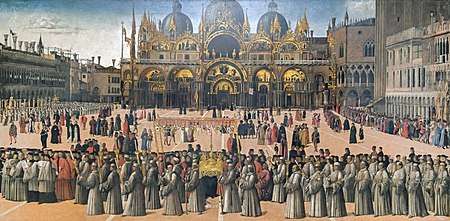
Venice exploited the situation and quickly installed nobility to govern the area, for example, Count Filippo Stipanov in Zara. This move by the Venetians was a response to the threatening expansion of Giangaleazzo Visconti, Duke of Milan. Control over the northeast main land routes was also a necessity for the safety of the trades. By 1410, Venice had a navy of 3,300 ships (manned by 36,000 men) and taken over most of what is now the Veneto, including the cities of Verona (which swore its loyalty in the Devotion of Verona to Venice in 1405) and Padua.[14]
The situation in Dalmatia had been settled in 1408 by a truce with King Sigismund of Hungary, but the difficulties of Hungary finally granted to the republic the consolidation of its Adriatic dominions. At the expiration of the truce in 1420, Venice immediately invaded the Patriarchate of Aquileia, and subjected Traù, Spalato, Durazzo, and other Dalmatian cities. In Lombardy, Venice acquired Brescia in 1426, Bergamo in 1428, and Cremona in 1499.
Slaves were plentiful in the Italian city-states as late as the 15th century. Between 1414 and 1423, some 10,000 slaves, imported from Caffa, were sold in Venice.[15]
In 1481, Venice retook nearby Rovigo, which it had held previously from 1395 to 1438; in February 1489, the island of Cyprus, previously a crusader state (the Kingdom of Cyprus), was added to Venice's holdings.
League of Cambrai, the loss of Cyprus, and Battle of Lepanto
The Ottoman Empire started sea campaigns as early as 1423, when it waged a seven-year war with the Venetian Republic over maritime control of the Aegean, the Ionian, and the Adriatic Seas. The wars with Venice resumed after the Ottomans captured the Kingdom of Bosnia in 1463, and lasted until a favorable peace treaty was signed in 1479 just after the troublesome siege of Shkodra. In 1480 (now no longer hampered by the Venetian fleet), the Ottomans besieged Rhodes and briefly captured Otranto. By 1490, the population of Venice had risen to about 180,000 people.[16]
War with the Ottomans resumed from 1499 to 1503. In 1499, Venice allied itself with Louis XII of France against Milan, gaining Cremona. In the same year, the Ottoman sultan moved to attack Lepanto by land, and sent a large fleet to support his offensive by sea. Antonio Grimani, more a businessman and diplomat than a sailor, was defeated in the sea battle of Zonchio in 1499. The Turks once again sacked Friuli. Preferring peace to total war both against the Turks and by sea, Venice surrendered the bases of Lepanto, Durazzo, Modon, and Coron.
Venice's attention was diverted from its usual maritime position by the delicate situation in Romagna, then one of the richest lands in Italy, which was nominally part of the Papal States, but effectively divided into a series of small lordships which were difficult for Rome's troops to control. Eager to take some of Venice's lands, all neighbouring powers joined in the League of Cambrai in 1508, under the leadership of Pope Julius II. The pope wanted Romagna; Emperor Maximilian I: Friuli and Veneto; Spain: the Apulian ports; the king of France: Cremona; the king of Hungary: Dalmatia, and each one some of another's part. The offensive against the huge army enlisted by Venice was launched from France.
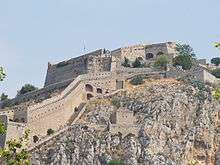
On 14 May 1509, Venice was crushingly defeated at the battle of Agnadello, in the Ghiara d'Adda, marking one of the most delicate points in Venetian history. French and imperial troops were occupying Veneto, but Venice managed to extricate itself through diplomatic efforts. The Apulian ports were ceded in order to come to terms with Spain, and Pope Julius II soon recognized the danger brought by the eventual destruction of Venice (then the only Italian power able to face kingdoms like France or empires like the Ottomans).
The citizens of the mainland rose to the cry of "Marco, Marco", and Andrea Gritti recaptured Padua in July 1509, successfully defending it against the besieging imperial troops. Spain and the pope broke off their alliance with France, and Venice regained Brescia and Verona from France, also. After seven years of ruinous war, the Serenissima regained its mainland dominions west to the Adda River. Although the defeat had turned into a victory, the events of 1509 marked the end of the Venetian expansion.
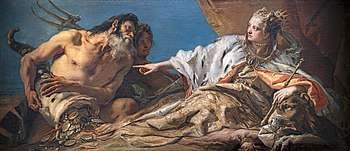
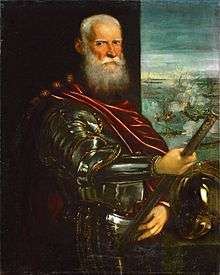
In 1489, the first year of Venetian control of Cyprus, Turks attacked the Karpasia Peninsula, pillaging and taking captives to be sold into slavery. In 1539, the Turkish fleet attacked and destroyed Limassol. Fearing the ever-expanding Ottoman Empire, the Venetians had fortified Famagusta, Nicosia, and Kyrenia, but most other cities were easy prey. By 1563, the population of Venice had dropped to about 168,000 people.[16]
In the summer of 1570, the Turks struck again, but this time with a full-scale invasion rather than a raid. About 60,000 troops, including cavalry and artillery, under the command of Mustafa Pasha landed unopposed near Limassol on 2 July 1570, and laid siege to Nicosia. In an orgy of victory on the day that the city fell – 9 September 1570 – 20,000 Nicosians were put to death, and every church, public building, and palace was looted.[17] Word of the massacre spread, and a few days later, Mustafa took Kyrenia without having to fire a shot. Famagusta, however, resisted and put up a defense that lasted from September 1570 until August 1571.
The fall of Famagusta marked the beginning of the Ottoman period in Cyprus. Two months later, the naval forces of the Holy League, composed mainly of Venetian, Spanish, and papal ships under the command of Don John of Austria, defeated the Turkish fleet at the Battle of Lepanto.[18] Despite victory at sea over the Turks, Cyprus remained under Ottoman rule for the next three centuries. By 1575, the population of Venice was about 175,000 people, but partly as a result of the plague of 1575–76 dropped to 124,000 people by 1581.[16]
17th century
According to economic historian Jan De Vries, Venice's economic power in the Mediterranean had declined significantly by the start of the 17th century. De Vries attributes this decline to the loss of the spice trade, a declining uncompetitive textile industry, competition in book publishing due to a rejuvenated Catholic Church, the adverse impact of the Thirty Years' War on Venice's key trade partners, and the increasing cost of cotton and silk imports to Venice.[19]
In 1606, a conflict between Venice and the Holy See began with the arrest of two clerics accused of petty crimes, and with a law restricting the Church's right to enjoy and acquire landed property. Pope Paul V held that these provisions were contrary to canon law, and demanded that they be repealed. When this was refused, he placed Venice under an interdict. The Republic paid no attention to the interdict or the act of excommunication, and ordered its priests to carry out their ministry. It was supported in its decisions by the Servite monk Paolo Sarpi, a sharp polemical writer who was nominated to be the Signoria's adviser on theology and canon law in 1606. The interdict was lifted after a year, when France intervened and proposed a formula of compromise. Venice was satisfied with reaffirming the principle that no citizen was superior to the normal processes of law.
The latter half of the 17th century also had prolonged wars with the Ottoman Empire; in the Cretan War (1645–1669), after a heroic siege that lasted 24 years, Venice lost its major overseas possession, the island of Crete, while it made some advances in Dalmatia. In 1684, however, taking advantage of the Ottoman involvement against Austria in the Great Turkish War, the republic initiated the Morean War, which lasted until 1699 and in which it was able to conquer the Morea peninsula in southern Greece.
18th century: decline
These gains did not last, however; in December 1714, the Turks began the last Turkish–Venetian War, when the Morea was "without any of those supplies which are so desirable even in countries where aid is near at hand which are not liable to attack from the sea".[20]

The Turks took the islands of Tinos and Aegina, crossed the isthmus, and took Corinth. Daniele Dolfin, commander of the Venetian fleet, thought it better to save the fleet than risk it for the Morea. When he eventually arrived on the scene, Nauplia, Modon, Corone, and Malvasia had fallen. Levkas in the Ionian islands, and the bases of Spinalonga and Suda on Crete, which still remained in Venetian hands, were abandoned. The Turks finally landed on Corfù, but its defenders managed to throw them back.
In the meantime, the Turks had suffered a grave defeat by the Austrians in the Battle of Petrovaradin on 5 August 1716. Venetian naval efforts in the Aegean Sea and the Dardanelles in 1717 and 1718, however, met with little success. With the Treaty of Passarowitz (21 July 1718), Austria made large territorial gains, but Venice lost the Morea, for which its small gains in Albania and Dalmatia were little compensation. This was the last war with the Ottoman Empire. By the year 1792, the once-great Venetian merchant fleet had declined to a mere 309 merchantmen.[21]
Although Venice declined as a seaborne empire, it remained in possession of its continental domain north of the Po Valley, extending west almost to Milan. Many of its cities benefited greatly from the Pax Venetiae (Venetian peace) throughout the 18th century.
Fall
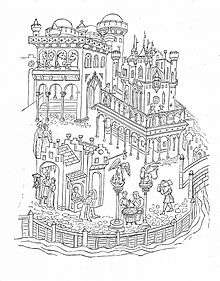
By 1796, the Republic of Venice could no longer defend itself since its war fleet numbered only four galleys and seven galliots.[22] In spring 1796, Piedmont fell, and the Austrians were beaten from Montenotte to Lodi. The army under Bonaparte crossed the frontiers of neutral Venice in pursuit of the enemy. By the end of the year, the French troops were occupying the Venetian state up to the Adige. Vicenza, Cadore and Friuli were held by the Austrians. With the campaigns of the next year, Napoleon aimed for the Austrian possessions across the Alps. In the preliminaries to the Peace of Leoben, the terms of which remained secret, the Austrians were to take the Venetian possessions in the Balkans as the price of peace (18 April 1797), while France required the Lombard part of the State.
After Napoleon's ultimatum, Doge Ludovico Manin surrendered unconditionally on 12 May, and abdicated, while the Major Council declared the end of the republic. According to Bonaparte's orders, the public powers passed to a provisional municipality under the French military governor. On 17 October, France and Austria signed the Treaty of Campo Formio, agreeing to share all the territory of the ancient republic, with a new border just west of the Adige River. Italian democrats, especially young poet Ugo Foscolo, viewed the treaty as a betrayal. The metropolitan part of the disbanded republic became an Austrian territory, under the name of Venetian Province (Provincia Veneta in Italian, Provinz Venedig in German).
Legacy
Though the economic vitality of the Venetian Republic had started to decline since the 16th century due to the movement of international trade towards the Atlantic, its political regime still appeared in the 18th century as a model for the philosophers of the enlightenment.
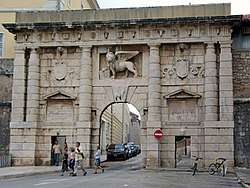 Relief of the Venetian Lion on the Landward Gate in Zara (Zadar), capital of the Venetian Dalmatia
Relief of the Venetian Lion on the Landward Gate in Zara (Zadar), capital of the Venetian Dalmatia Relief of the Venetian Lion in Parenzo (Poreč)
Relief of the Venetian Lion in Parenzo (Poreč)_-_Statue_of_the_Lion_of_Saint_Mark.jpg)
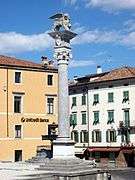

- Relief of the Venetian Lion in Cattaro (Kotor)
 Relief of the Venetian Lion on Candia (Crete)
Relief of the Venetian Lion on Candia (Crete)
Jean-Jacques Rousseau was hired in July 1743 as Secretary by comte de Montaigu, who had been named Ambassador of the French in Venice. This short experience, nevertheless, awakened the interest of Rousseau to the policy, which led him to design a large book of political philosophy.[23] After the Discourse on the Origin and Basis of Inequality Among Men (1755), he published The Social Contract (1762).
Government
In the early years of the republic, the Doge of Venice ruled Venice in an autocratic fashion, but later his powers were limited by the promissione ducale, a pledge he had to take when elected. As a result, powers were shared with the Maggior Consiglio or Great Council, composed of 480 members taken from patrician families, so that in the words of Marin Sanudo, "[The Doge] could do nothing without the Great Council and the Great Council could do nothing without him".
Venice followed a mixed government model, combining monarchy in the doge, aristocracy in the senate, republic of Rialto families in the major council, and a democracy in the concio.[24] Machiavelli considered it "excellent among modern republics" (unlike his native Florence).[25][26]
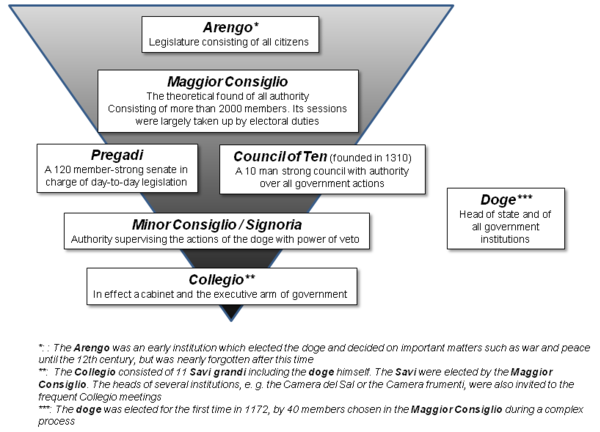
In the 12th century, the aristocratic families of Rialto further diminished the doge's powers by establishing the Minor Council (1175), composed of the six ducal councillors, and the Council of Forty or Quarantia (1179) as a supreme tribunal. In 1223, these institutions were combined into the Signoria, which consisted of the doge, the Minor Council, and the three leaders of the Quarantia. The Signoria was the central body of government, representing the continuity of the republic as shown in the expression: "si è morto il Doge, no la Signoria" ("If the Doge is dead, the Signoria is not").
During the late 14th and early 15th centuries, the Signoria was supplemented by a number of boards of savii ("wise men"): the six savii del consiglio, who formulated and executed government policy; the five savii di terraferma, responsible for military affairs and the defence of the Terraferma; and the five savii ai ordini, responsible for the navy, commerce, and the overseas territories. Together, the Signoria and the savii formed the Full College (Pien Collegio), the de facto executive body of the Republic.
In 1229, the Consiglio dei Pregadi or Senate, was formed, being 60 members elected by the major council.[27] These developments left the doge with little personal power and put actual authority in the hands of the Great Council.
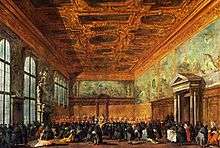
In 1310, a Council of Ten was established, becoming the central political body whose members operated in secret. Around 1600, its dominance over the major council was considered a threat and efforts were made in the council and elsewhere to reduce its powers, with limited success.
In 1454, the Supreme Tribunal of the three state inquisitors was established to guard the security of the republic. By means of espionage, counterespionage, internal surveillance, and a network of informers, they ensured that Venice did not come under the rule of a single "signore", as many other Italian cities did at the time. One of the inquisitors – popularly known as Il Rosso ("the red one") because of his scarlet robe – was chosen from the Doge's councillors, two – popularly known as I negri ("the black ones") because of their black robes – were chosen from the Council of Ten. The Supreme Tribunal gradually assumed some of the powers of the Council of Ten.[27]
In 1556, the provveditori ai beni inculti were also created for the improvement of agriculture by increasing the area under cultivation and encouraging private investment in agricultural improvement. The consistent rise in the price of grain during the 16th century encouraged the transfer of capital from trade to the land.
Military
During the Medieval period, the republic's military was composed of the following elements:
- Forza ordinari (ordinary force), the oarsmen drafted from the citizens of the City of Venice; everyone from the age of 20–70 was obligated to serve in it. However, generally only a twelfth was active.
- Forza sussidiaria (subsidiary force), the military force drawn from Venice's overseas possessions.
- Forza straordinari (extraordinary force), the mercenary part of the army; Venetian galleys tended to employ thirty mercenary crossbowmen. With the rise of scutage, it became the dominant element of the Venetian military.[28]
Heraldry
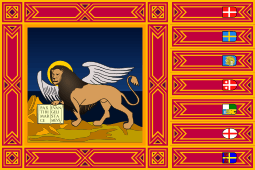
The winged Lion of St. Mark, which had appeared on the Republic's flag and coat of arms, is still featured in the red-yellow flag of the city of Venice (which has six tails, one for each sestier of the city), in the coat of arms of the city and in the yellow-red-blue flag of Veneto (which has seven tails representing the seven provinces of the region).
The winged lion also appears in the naval ensign of the Italian Republic, alongside the coat of arms of three other medieval Italian maritime republics (Genoa, Pisa, and Amalfi).
See also
- Commune Veneciarum
- History of the Byzantine Empire
- Italian Wars (1494–1559)
- List of historic states of Italy
- Ottoman wars in Europe
- Republic of San Marco (1848–49)
- Timeline of the Republic of Venice
- Venetian Albania
- Venetian Carnival
- Venetian Gothic architecture
- Venetian Ionian Islands
- Venetian nationalism
- Venetian navy
- Venetian School (art)
- Venetian School (music)
- Venetian Slovenia
- Wars in Lombardy (1425–54)
- Taganrog
References
Citations
- See for example Giacomo Diedo Senatore (1751). Storia della Repubblica di Venezia sino l'anno MDCCXLVII (in Italian). Venice: Stamperia Andrea Poletti. Also Del Mar Adriatico della Serenissima Republica di Venetia, descritto da Fr. Paolo Sarpi suo consultore d'ordine pubblico (in Italian). Venice: Stamperia Roberto Meietti. 1685.
- See for example Petri Pauli Vergerii senioris Justinopolitani De republica Veneta fragmenta nunc primum in luce edita (in Latin). Venice: Tipografia Picottiana. 1830.
- J. J. Norwich, A History of Venice, p. 32.
- J. J. Norwich, A History of Venice, p. 53.
- J. J. Norwich, A History of Venice, p. 72.
- J. J. Norwich, A History of Venice, p. 83.
- J. J. Norwich, A History of Venice, p. 77.
- Phillips, The Fourth Crusade and the Sack of Constantinople, Introduction, xiii.
- C.Michael Hogan, Cydonia, Modern Antiquarian, 23 January 2008
- Van Tricht 2011, p. 160.
- Anja Thaller, "«Desiderosi Trivisani de festizar in laude de la bona pase». Zur Neubewertung der “Liebesburgbelagerung” von Treviso", Reti Medievali Rivista 17.2 (2016): 385–418.
- The enemy within: a history of espionage, General Military, p.49, Terry Crowdy, Osprey Publishing, 2006. ISBN 978-1-84176-933-2
- J. J. Norwich, A History of Venice, p. 176–180.
- J. J. Norwich, A History of Venice, p. 269.
- Witzenrath, Christoph (November 2015). Eurasian Slavery, Ransom and Abolition in World History, 1200–1860 (New ed.). Ashgate. p. 13. ISBN 978-1472410580. Retrieved 23 December 2015.
- J. J. Norwich, A History of Venice, p. 494.
- Turnbull, Stephen (2003). The Ottoman Empire 1326–1699. Routledge. p. 58. ISBN 978-0-415-96913-0.
- Melisseides Ioannes A. (2010). "E epibiose:odoiporiko se chronus meta ten Alose tes Basileusas (1453–1605 peripou)", (in Greek), epim.Pulcheria Sabolea-Melisseide, Ekd.Vergina, Athens (Worldcat, Regesta Imperii, etc.), p.91-108, ISBN 9608280079
- De Vries, Jan. "Europe in an age of crisis 1600–1750". Cambridge University Press. p. 26. Retrieved 2 September 2018.
- Zorzi, Alvise (1983). Venice: The Golden Age, 697 – 1797. New York: Abbeville Press. p. 255. ISBN 0896594068. Retrieved 16 September 2017.
- J. J. Norwich, A History of Venice, p. 591.
- J. J. Norwich, A History of Venice, p. 615.
- Raymond Trousson, Jean-Jacques Rousseau, Tallandier, p. 452
- The Political Ideas of St. Thomas Aquinas, Dino Bigongiari ed., Hafner Publishing Company, NY, 1953. p. xxx in footnote.
- Niccolò Machiavelli, The Prince, trans. & ed. by Robert M. Adams, W.W. Norton & Co., NY, 1992. Machiavelli Balanced Government
- Niccolò Machiavelli, Discourses on Livy, trans. by Harvey C. Mansfield and Nathan Tarcov, University of Chicago Press, Chicago, 1996.
- Catholic Encyclopedia, "Venice", p. 602.
- Heath, Ian (2016). Armies of Feudal Europe 1066-1300. pp. 62–65. ISBN 9781326256524.
Sources
Primary sources
- Contarini, Gasparo (1599). The Commonwealth and Government of Venice. Lewes Lewkenor, translator. London: "Imprinted by I. Windet for E. Mattes". The most important contemporary account of Venice's governance during the time of its blossoming; numerous reprint editions; online facsimile.
Secondary sources
- Benvenuti, Gino (1989). Le repubbliche marinare. Rome: Newton Compton.
- Brown, Patricia Fortini (2004). Private Lives in Renaissance Venice: art, architecture, and the family.
- Chambers, D. S. (1970). The Imperial Age of Venice, 1380–1580. London: Thames & Hudson. The best brief introduction in English, still completely reliable.
- Drechsler, Wolfgang (2002). Venice Misappropriated. Trames 6(2):192–201. A scathing review of Martin & Romano 2000; also a good summary on the most recent economic and political thought on Venice.
- Garrett, Martin (2006). Venice: a Cultural History. Revised edition of Venice: a Cultural and Literary Companion (2001).
- Grubb, James S. (1986). When Myths Lose Power: Four Decades of Venetian Historiography. Journal of Modern History 58, pp. 43–94. The classic "muckraking" essay on the myths of Venice.
- Howard, Deborah, and Sarah Quill (2004). The Architectural History of Venice.
- Hale, John Rigby (1974). Renaissance Venice. ISBN 0-571-10429-0.
- Karpov, Serghei (2017). Ortalli, Gherardo; Sopracasa, Alessio (eds.). "La Tana veneziana. Vita economica e rapportisociali: i tentativi di superare la grande crisi della metà del Trecento". Rapporti Mediterranei, Pratiche Documentarie, Presenze Veneziane: Le Reti Economiche e Culturali (XIV - XVI Secolo). Estratto (in Italian). Venezia: Istituto Veneto di Scienze, Lettere ed Arti: 237–252. ISBN 978-88-95996-69-1.
- Lane, Frederic Chapin (1973). Venice: Maritime Republic. ISBN 0-8018-1445-6. A standard scholarly history with an emphasis on economic, political and diplomatic history.
- Laven, Mary (2002). Virgins of Venice: Enclosed Lives and Broken Vows in the Renaissance Convent. The most important study of the life of Renaissance nuns, with much on aristocratic family networks and the life of women more generally.
- Mallett, M. E. and Hale, J. R. (1984). The Military Organisation of a Renaissance State, Venice c. 1400 to 1617. ISBN 0-521-03247-4.
- Martin, John Jeffries and Dennis Romano (eds.) (2002). Venice Reconsidered: The History and Civilization of an Italian City-State, 1297–1797. Johns Hopkins UP. The most recent collection on essays, many by prominent scholars, on Venice.
- Melisseides Ioannes A. (2010), E epibiose:odoiporiko se chronus meta ten Alose tes Basileusas (1453–1605 peripu), (in Greek), epim.Pulcheria Sabolea-Melisseide, Ekd.Vergina Athens, (Worldcat, Greek National Bibliography 9217/10, Regesta Imperii, etc.), p. 91–108, ISBN 9608280079
- Muir, Edward (1981). Civic Ritual in Renaissance Venice. Princeton UP. The classic of Venetian cultural studies, highly sophisticated.
- Norwich, John Julius (1982). A History of Venice. New York City: Alfred A. Knopf.
- Prelli, Alberto. Sotto le bandiere di San Marco, le armate della Serenissima nel '600, Itinera Progetti, Bassano del Grappa, 2012
- Rosand, David (2001). Myths of Venice: The Figuration of a State. How writers (especially English) have understood Venice and its art.
- Tafuri, Manfredo (1995). Venice and the Renaissance. On Venetian architecture.
- Tafel, Gottlieb Lukas Friedrich, and Georg Martin Thomas (1856). Urkunden zur älteren Handels- und Staatsgeschichte der Republik Venedig.
- Tomaz, Luigi (2007). Il confine d'Italia in Istria e Dalmazia. Foreword by Arnaldo Mauri. Conselve: Think ADV.
- Tomaz, Luigi. In Adriatico nel secondo millennio. Foreword by Arnaldo Mauri.
- Tomaz, Luigi (2001). In Adriatico nell'antichità e nell'alto medioevo. Foreword by Arnaldo Mauri. Conselve: Think ADV.
External links
| Wikimedia Commons has media related to Republic of Venice. |
